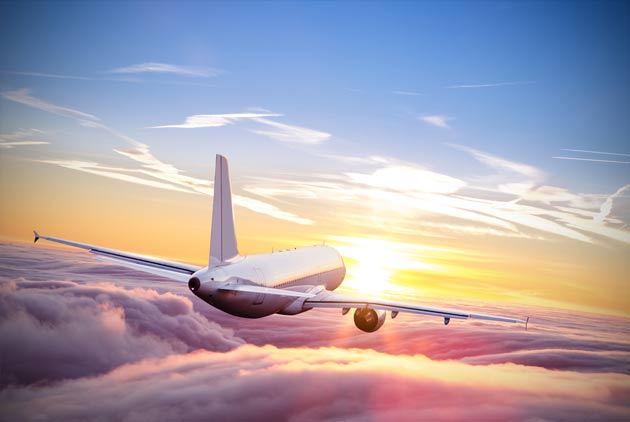World Economic Forum
New York to London in 90 Minutes? These Companies Think It's Possible

Source:Shutterstock
Boeing say they will have a working hypersonic prototype within 10 years.
Views
New York to London in 90 Minutes? These Companies Think It's Possible
By David Elliottweb only
When Concorde landed for the final time in London, the crowds saw their dreams of flying faster than the speed of sound grounded along with the legendary plane.
But now, a little over 15 years later, plans for ultra-fast air travel are once again taking off. Companies like Lockheed Martin and Boom, which is backed by the Virgin Group and Japan Airlines, are developing new supersonic aircraft.
And some in the industry are thinking even faster – they’re going hypersonic.
US start-up Hermeus is developing a plane to fly five times faster than the speed of sound, at what’s known as Mach 5. It would be able to travel from New York to London in 90 minutes.
The Atlanta-based firm isn’t alone. The UK’s Reaction Engines, working with the European Space Agency and the UK Space Agency, has announced a breakthrough in engine technology it says is a milestone in the journey to Mach 5 flights. And Boeing has unveiled a sleek concept for its own hypersonic jet.
So we could soon be nipping across the Atlantic in less time than it takes to watch the average movie. But will people – and more importantly the planet – welcome the move?
 Boeing says its hypersonic plane could be used for commercial or military purposes. (Image: Boeing)\
Boeing says its hypersonic plane could be used for commercial or military purposes. (Image: Boeing)\
In for The Long Haul
Research into hypersonic travel goes back decades. In the 1960s, the US Air Force and NASA experimented with the rocket-powered X-15, which recorded speeds of more than 7,000 kilometres per hour – Mach 6.7.
Since then, progress has been limited. Just a few aircraft have flown hypersonic since, including Boeing’s X-51 WaveRider, which completed its first test flight in 2010.
The company has been working on the technology for about six decades, and it says advances in materials, engines and flight simulation are bringing it closer to commercial application. But there are still barriers to getting it off the ground.
A hypersonic plane would have to be built to withstand the extreme temperaturescaused by air friction at such high speeds. And new propulsion systems would be needed to operate efficiently at more than 6,000 km per hour.
Then there’s the noise. When a plane breaks the sound barrier, it creates a sonic boom. It’s so loud it can damage human ears, limiting the routes such planes can fly.
Have you read?
♦ Which Are the Most Punctual Airlines?
♦ The Heroine of Taiwan’s Aviation Industry
♦ Air Travel in Asia is Taking Off
Is It What We Want?
Boeing, BAE Systems, NASA and Lockheed Martin are among the organizations working to solve these problems. But will there be a market for hypersonic travel once they do?
The International Air Transport Association (IATA) predicts that by 2037 the number of air passengers could double to 8.2 billion a year. With that many people in the air, drastically reduced flight times could benefit both passengers and airlines.
Boom has said a seat on one of its supersonic flights would cost no more than a business class ticket today. And Hermeus thinks a one-way ticket between New York and London on its hypersonic plane would cost $3,000. Being able to fly across the world for a business meeting and be home for dinner would no doubt be attractive for some.
Even if passengers were willing to pay a premium for that privilege, though, there’s another question facing the industry: the environmental impact.

What about The Planet?
The aviation industry has committed to cutting its environmental footprint. Under an International Civil Aviation Organization scheme, the IATA has said it will work to cut its emissions by offseting 2.5 billion tonnes of CO2 by 2035.
An International Council on Clean Transportation report warns supersonic flights would be unlikely to meet such environmental standards. They burn up to seven times more fuel, it says, which would exceed CO2 emissions limits by 70%.
Hypersonic engines such as those being built by Reaction Engines could sidestep this issue by using hydrogen fuel. As well as potential safety benefits, hydrogen engines do not emit greenhouse gases.
But they might create a different problem – the water vapour they produce would hang in the stratosphere and could contribute to global warming.
 Image: Statista
Image: Statista
Preparing for Departure
If these hurdles can be overcome, we could be cruising at Mach 5 within decades.
Boeing says it will have a working prototype in less than 10 years, with commercial flights taking to the skies in 20 to 30 years. And Hermeus says it will take about a decade to develop its aircraft.
When they do take off, hypersonic planes would need to fly at around 90,000 feet. At that altitude it’s possible to see the darkness of space above.
Getting there might once have seemed like an astronomical feat. But dreams of travelling faster than the speed of sound appear to be moving closer once again.
Original content can be found at the website of World Economic Forum: New York to London in 90 minutes? These companies think it's possible
This article is reproduced under the permission of World Economic Forum (WEF) and terms of Creative Commons Attribution-NonCommercial-NoDerivs 4.0 Unported License (“CCPL”). It presents the opinion or perspective of the original author / organization, which does not represent the standpoint of CommonWealth magazine.






